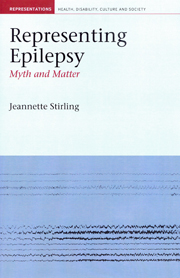Book contents
- Frontmatter
- Contents
- Acknowledgements
- Introduction
- 1 From Hippocrates to Shakespeare and Dickens: epilepsy's entry into ‘the circuit of culture’
- 2 Hystericity and hauntings: the female and the feminised
- 3 Notes from the borderlands: repressing the returned
- 4 The colonies
- 5 Because you're ‘you know. That way’
- Where to next? The ongoing story of epilepsy
- Bibliography
- Index
3 - Notes from the borderlands: repressing the returned
- Frontmatter
- Contents
- Acknowledgements
- Introduction
- 1 From Hippocrates to Shakespeare and Dickens: epilepsy's entry into ‘the circuit of culture’
- 2 Hystericity and hauntings: the female and the feminised
- 3 Notes from the borderlands: repressing the returned
- 4 The colonies
- 5 Because you're ‘you know. That way’
- Where to next? The ongoing story of epilepsy
- Bibliography
- Index
Summary
I'm just a soul whose intentions are good.
Oh Lord! – Please don't let me be misunderstood.
(Gloria Caldwell, Bennie Benjamin and Sol Marcus, ‘Don't let me be misunderstood’, 1964)In 1886, almost fifty years after Monks seized the reading public's imagination and his ‘evil passions, vice, and profligacy’ found expression in the ‘hideous disease’ that figured him epileptic, Robert Louis Stevenson published his novella Strange Case of Dr Jekyll and Mr Hyde. Through the character of the physician, Henry Jekyll, and his alter-ego, Edward Hyde, Stevenson explores nineteenth-century social and cultural conventions that seem to necessitate a double self. In doing so, he raises questions about identity, specifically in relation to the impossible yet necessary repressions entailed in constituting an identity that is both socially appropriate and seemingly integrated.
On 10 January 1894 a London physician, Arthur Thomas Myers, died at forty-two years of age. His untimely death continues to resonate through medical circles to the present day. Meteorological records indicate that Londoners experienced an unusually warm, damp January in the year Myers died, a fact referred to by one of the physicians involved in the deceased's autopsy. According to post-mortem findings, the cause of the physician's death was medical complications associated with his epilepsy, exacerbated by the narcotic medicine he took as part of the treatment for his condition.
- Type
- Chapter
- Information
- Representing EpilepsyMyth and Matter, pp. 81 - 130Publisher: Liverpool University PressPrint publication year: 2010

